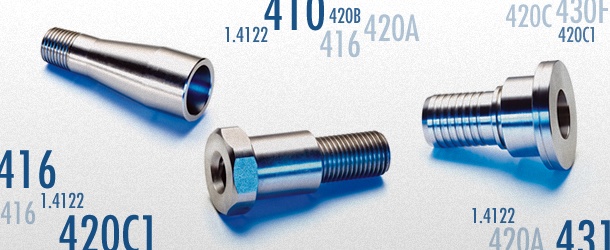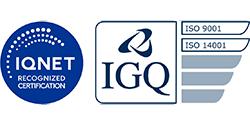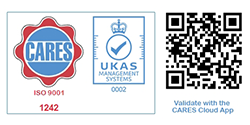
Stainless steels martensitic
Corrosion-resistant, temperable steels
Martensitic stainless steels, as is the case of quenched and tempered steels, can be tempered. For this reason the products can be provided in both the annealed state (a treatment that improves their machinability and deformability) and in the quenched and tempered state (which instead enhances their mechanical strength and corrosion resistance characteristics).
In order to achieve high surface hardness values, it is finally possible to subject these steels also to induction hardening after chip removal machining.
As with the other steels, the versions with the addition of sulfur lend themselves more easily to machining by chip removal.
RANGE Stainless steels martensitic
-
Rodacciai Mark
410
Steel name
X12Cr13 - Nr.1.4006
Basic martensitic steel with a low carbon content, a characteristic that on one hand limits temperability and mechanical characteristics after tempering, and on the other increases versatility. Suitable for all those fields in which very high mechanical characteristics are not required. Corrosion resistance sufficient for non-demanding applications.
-
Rodacciai Mark
416
Steel name
X12CrS13 - Nr.1.4005
Steel similar to the previous one; the addition of sulfur improves machinability by chip removal, but reduces resistance to corrosion, which in any case is improved with the material at the quenched and tempered state.
-
Rodacciai Mark
420A
Steel name
X20Cr13 - Nr.1.4021
Widely used quenched and tempered steel, with mechanical characteristics superior to those of the 410 base type at the quenched and tempered state.
-
Rodacciai Mark
420B
Steel name
X30Cr13 - Nr.1.4028
Probably the most popular of the martensitic stainless steels, it has a higher carbon content than the previous type, and combines good corrosion resistance, good deformability at the annealed state and good temperability. Used for pump shafts, electric motor shafts, tools and cutlery.
-
Rodacciai Mark
420C
Steel name
X39Cr13 - Nr.1.4031
Martensitic stainless steel with a high carbon content, suitable for pieces with an elevated hardness such as tools, cutlery, and blades in general. After quenching and tempering the surface can also be hardened by induction tempering.
-
Rodacciai Mark
420C1
Steel name
X46Cr13 - Nr.1.4034
Similar to the above but with a higher carbon content, suitable for small pieces with high hardness, including rollers and balls for special bearings.
-
Rodacciai Mark
430F
Steel name
X14CrMoS17 - Nr.1.4104
Martensitic steel with low temperability. The addition of sulfur makes this type widely used for mechanical machining with chip removal, also without the quenching and tempering treatment. The resistance to corrosion is limited due to the presence of sulfur, but is better in any case with respect to the 416 type thanks to the addition of molybdenum.
-
Rodacciai Mark
1.4122
Steel name
X39CrMo17-1 - Nr.1.4122
Steel similar to 420C but with the addition of molybdenum, which increases its resistance to corrosion at high temperature.
-
Rodacciai Mark
431
Steel name
X17CrNi16-2 Nr.1.4057
Martensitic stainless steel with the addition of nickel, which improves its resistance to corrosion. It is widely used even if, due to the limited carbon content, it has average mechanical characteristics.
-
Rodacciai Mark
631M
Steel name
X7CrNiAI17-7 - Nr.1.4568
Precipitation hardening stainless steel with high corrosion resistance and also high mechanical characteristics
-
Rodacciai Mark
X46CRS13
Steel name
X46CrS13 - Nr.1.4035
Martensitic stainless steel that contains high % of carbon that allows heat treatments and sulfur that allows high workability








